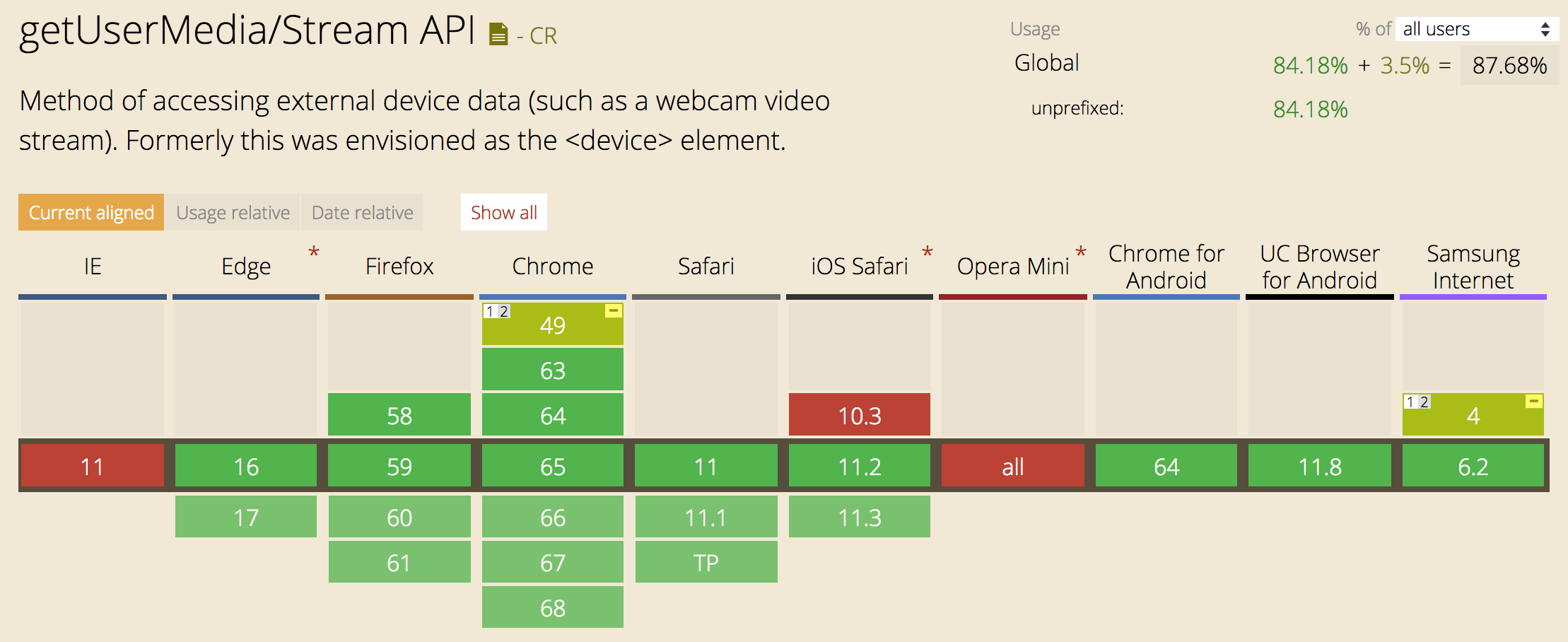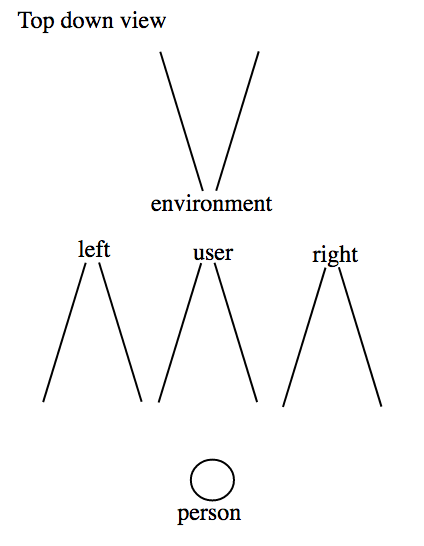jslib-html5-camera-photo v3.3.4
jslib-html5-camera-photo
The first objective of this package comes from the need to have a js library that can help me to capture picture from mobile or desktop camera through the browser with the HTML5 video and canvas elements. So instead of using the native navigator.mediaDevices.getUserMedia() and manage the stream and the constraints, i need an abstraction it into a small lib that can switch between camera and get the desired resolution.
Another js camera ? Yes! I found webcamjs and jpeg_camera but i need to switch easily from camera environment and user. You need to build the constraint for getUserMedia()... Another need is to have a sizeFactor instead of a fixing 'width' and 'height' that can not fit with the ratio of the resolution that camera can pick.
Features of the library.
- Choose between
facing modeordeviceIdcamera, fall back to the default camera. - Set
ideal resolution, fall back to the default resolution. - Get the
maximum resolutionof the camera, fall back to the default resolution. - Choose dataURI
image formattype betweenjpgorpng. - If image format is
jpg, choose thecompression valueis the between 0, 1. - Choose dataURI
image mirrorif you want to get an mirror dataURI of the camera.
Simple Live Demo
https://mabelanger.github.io/jslib-html5-camera-photo/
supported browsers (getUserMedia)
https://caniuse.com/#search=getUserMedia
 ...(as April 2018)
...(as April 2018)
Available camera facingModes
| FACING_MODES [] | Description |
|---|---|
| USER | The source is facing toward the user (a self-view camera). |
| ENVIRONMENT | The source is facing away from the user (viewing the environment). |
Below is an illustration of the video facing modes in relation to the user.

src : https://www.w3.org/TR/mediacapture-streams/#dom-videofacingmodeenum
Getting started
You can use the library with vanilla JavaScript, React, Jquery, Angular...
Installation
npm install --save jslib-html5-camera-photoyarn add jslib-html5-camera-photoUsage
Constructor
import CameraPhoto, { FACING_MODES, IMAGE_TYPES } from 'jslib-html5-camera-photo';
// get your video element with his corresponding id from the html
let videoElement = document.getElementById('videoId');
// pass the video element to the constructor.
let cameraPhoto = new CameraPhoto(videoElement);parameters of startCamera
cameraPhoto.startCamera(cameraDevice, resolution)| parameters | Description |
|---|---|
| cameraDevice | Is the string of the camera facingMode or deviceId |
| resolution | Is the object resolution ex:. { width: 640, height: 480 } |
Start the default mode (facing Mode & resolution)
If you do not specify any prefer resolution and facing mode, the default is used. The function return a promise. If the promises success it will give you the stream if you want to use it. If it fail, it will give you the error.
// default camera and resolution
cameraPhoto.startCamera()
.then((stream)=>{/* ... */})
.catch((error)=>{/* ... */});Start with ideal facing Mode & default resolution
// environment (camera point to environment)
cameraPhoto.startCamera(FACING_MODES.ENVIRONMENT, {})
.then((stream)=>{/* ... */})
.catch((error)=>{/* ... */});
// OR user (camera point to the user)
cameraPhoto.startCamera(FACING_MODES.USER, {})
.then((stream)=>{/* ... */})
.catch((error)=>{/* ... */});Start with a user-selected deviceId & default resolution
Instead of facing mode, you can specify the deviceId (camera) that you want to use. To know the device id you can get a list of them using see Enumerate the available cameras, so you can start the camera with the deviceId instead of facing mode, e.g.
// OR specify the deviceId (use a specific camera)
const deviceId = 'the_string_of_device_id';
cameraPhoto.startCamera(deviceId, {})
.then((stream)=>{/* ... */})
.catch((error)=>{/* ... */});Start with ideal (facing Mode & resolution)
// example of ideal resolution 640 x 480
cameraPhoto.startCamera(facingMode, {width: 640, height: 480})
.then((stream)=>{/* ... */})
.catch((error)=>{/* ... */});Start with the maximum resolution
It will try the range of width [3840, 2560, 1920, 1280, 1080, 1024, 900, 800, 640, default] px to take the maximum width of 3840px if it can't, 2560px and so on ... until the fall back of the default value of the camera. The facingMode is optional.
// It will try the best to get the maximum resolution with the specified facingMode
cameraPhoto.startCameraMaxResolution(cameraDevice)
.then((stream)=>{/* ... */})
.catch((error)=>{/* ... */});getDataUri()
Function that return the dataUri of the current frame of the camera.
To use that function build the configuration object with the corresponding properties. To use the default value, just ommit the parameter:
Parameter (object config)
sizeFactor (Number): Used to get a desired resolution. Example, a sizeFactor of
1get the same resolution of the camera while sizeFactor of0.5get the half resolution of the camera. The sizeFactor can be between range of]0, 1]and the default value is1.imageType (String): Used to get the desired image type between
jpgorpng. to specify the imageType use the constant IMAGE_TYPES, for example to specify jpg format use IMAGE_TYPES.JPG. The default imageType ispng.imageCompression (Number): Used to get the desired compression when
jpgis selected. choose a compression between[0, 1], 1 is maximum, 0 is minimum. The default value imageCompression is0.92.isImageMirror (Boolean): Used to get an image mirror when is set to
true, the result of thedataUriis the mirror of the actual camera data. Many software that use camera mirror like hangout etc... Please note if you want to enable this option, for consistency with the camera video, you need to use csstransform: rotateY(180deg)to the <video> tag to mirror the stream, because the stream is not mirrored. It's only apply to the canvas dataUri. The default value isfalse(no mirror).
Available image types
| IMAGE_TYPES [] | Description |
|---|---|
| JPG | set image image/jpeg to the data URI |
| PNG | set image image/png to the data URI (the default value) |
// Use all the default value
const config = {};
let dataUri = cameraPhoto.getDataUri(config);
// OR
// Specify sizeFactor, imageType, imageCompression, isImageMirror
const config = {
sizeFactor : 1;
imageType : IMAGE_TYPES.JPG
imageCompression : .95;
isImageMirror : false;
}
let dataUri = cameraPhoto.getDataUri(config);Get the camera settings
the function return null if no stream exist (camera not started) or an object with the camera settings attributes of (aspectRatio, frameRate, height, width).
let cameraSettigs = cameraPhoto.getCameraSettings();
if (cameraSettigs) {
let {aspectRatio, frameRate, height, width} = cameraSettigs;
let settingsStr =
`aspectRatio:${aspectRatio} ` +
`frameRate: ${frameRate} ` +
`height: ${height} ` +
`width: ${width}`;
console.log(settingsStr);
}Enumerate the available cameras
enumerateCameras() Return a Promise that receives an array of MediaDeviceInfo ie:. {kind, label, deviceId} when the promise is fulfilled. Each object in the array describes one of the available camera (only device-types for which permission has been granted are "available"). The order is significant - the default capture devices will be listed first. If the camera is open, it will only return the promise. If the camera is close, it make sure that camera is granted before returning the promise ie:. do a start/stop cycle of the camera that goes on for 20 ms.
cameraPhoto.enumerateCameras()
.then((cameras)=>{
cameras.forEach((camera) => {
let {kind, label, deviceId} = camera;
let cameraStr = `
kind: ${kind}
label: ${label}
deviceId: ${deviceId}
`;
console.log(cameraStr)
});
})plugin - download photo
You can download photo of the dataUri that you took and pass it to downloadPhoto() function.
import { downloadPhoto } from 'jslib-html5-camera-photo';
let dataUri = cameraPhoto.getDataUri(config);
downloadPhoto(dataUri, prefixFileName, number);
// The filename will be saved as the format :
`${prefixFileName}-${number}.jpg|png}`the parameters of the downloadPhoto() function
| parameters | Description |
| -------------- | ------------------------------------------------------------- |
| dataUri | Is dataUri of the photo |
| prefixFileName | Is the string prefix of the fileName |
| number | Is the integer number prefix of the fileName with 0 padding |
Stop the camera
Function that stop the camera. If it success, no value is returned. It can fail if they is no camera to stop because the camera has already been stopped or never started. It will give a parameter of Error('no stream to stop!'). Note that each time we start the camera, it internally using this stop function to be able to apply new constraints.
// It stop the camera
cameraPhoto.stopCamera()
.then(()=>{/* ... */})
.catch((error)=>{/* ... */});Full example vanilla Js & HTML
HTML
<!-- needed to by the camera stream -->
<video id="videoId" autoplay="true"></video>
<!-- needed if you want to display the image when you take a photo -->
<img alt="imgId" id="imgId">
<!--buttons to trigger the actions -->
<button id="takePhotoButtonId">takePhoto</button>
<button id="stopCameraButtonId">stopCamera</button>JavaScript
import CameraPhoto, { FACING_MODES } from 'jslib-html5-camera-photo';
// get video and image elements from the html
let videoElement = document.getElementById('videoId');
let imgElement = document.getElementById('imgId');
// get buttons elements from the html
let takePhotoButtonElement = document.getElementById('takePhotoButtonId');
let stopCameraButtonElement = document.getElementById('stopCameraButtonId');
// instantiate CameraPhoto with the videoElement
let cameraPhoto = new CameraPhoto(videoElement);
/*
* Start the camera with ideal environment facingMode
* if the environment facingMode is not available, it will fallback
* to the default camera available.
*/
cameraPhoto.startCamera(FACING_MODES.ENVIRONMENT)
.then(() => {
console.log('Camera started !');
})
.catch((error) => {
console.error('Camera not started!', error);
});
// function called by the buttons.
function takePhoto () {
const config = {};
let dataUri = cameraPhoto.getDataUri(config);
imgElement.src = dataUri;
}
function stopCamera () {
cameraPhoto.stopCamera()
.then(() => {
console.log('Camera stoped!');
})
.catch((error) => {
console.log('No camera to stop!:', error);
});
}
// bind the buttons to the right functions.
takePhotoButtonElement.onclick = takePhoto;
stopCameraButtonElement.onclick = stopCamera;Full example with React
A project with react is build with this library react-html5-camera-photo
import React from 'react';
import CameraPhoto, { FACING_MODES } from 'jslib-html5-camera-photo';
class App extends React.Component {
constructor (props, context) {
super(props, context);
this.cameraPhoto = null;
this.videoRef = React.createRef();
this.state = {
dataUri: ''
}
}
componentDidMount () {
// We need to instantiate CameraPhoto inside componentDidMount because we
// need the refs.video to get the videoElement so the component has to be
// mounted.
this.cameraPhoto = new CameraPhoto(this.videoRef.current);
}
startCamera (idealFacingMode, idealResolution) {
this.cameraPhoto.startCamera(idealFacingMode, idealResolution)
.then(() => {
console.log('camera is started !');
})
.catch((error) => {
console.error('Camera not started!', error);
});
}
startCameraMaxResolution (idealFacingMode) {
this.cameraPhoto.startCameraMaxResolution(idealFacingMode)
.then(() => {
console.log('camera is started !');
})
.catch((error) => {
console.error('Camera not started!', error);
});
}
takePhoto () {
const config = {
sizeFactor: 1
};
let dataUri = this.cameraPhoto.getDataUri(config);
this.setState({ dataUri });
}
stopCamera () {
this.cameraPhoto.stopCamera()
.then(() => {
console.log('Camera stoped!');
})
.catch((error) => {
console.log('No camera to stop!:', error);
});
}
render () {
return (
<div>
<button onClick={ () => {
let facingMode = FACING_MODES.ENVIRONMENT;
let idealResolution = { width: 640, height: 480 };
this.startCamera(facingMode, idealResolution);
}}> Start environment facingMode resolution ideal 640 by 480 </button>
<button onClick={ () => {
let facingMode = FACING_MODES.USER;
this.startCamera(facingMode, {});
}}> Start user facingMode resolution default </button>
<button onClick={ () => {
let facingMode = FACING_MODES.USER;
this.startCameraMaxResolution(facingMode);
}}> Start user facingMode resolution maximum </button>
<button onClick={ () => {
this.takePhoto();
}}> Take photo </button>
<button onClick={ () => {
this.stopCamera();
}}> Stop </button>
<video
ref={this.videoRef}
autoPlay="true"
/>
<img
alt="imgCamera"
src={this.state.dataUri}
/>
</div>
);
}
}
export default App;import the UMD module with HTML script tag
You can build the dist and then serve it with :
$ npm run buildBrowser
$ npm run serve:distOr you can copy the dist folder of the repo.
Example :
<script src="/jslib-html5-camera-photo.min.js"></script>
<script>
...
var FACING_MODES = JslibHtml5CameraPhoto.FACING_MODES;
var cameraPhoto = new JslibHtml5CameraPhoto.default(videoElement);
...
</scriptDevelopment
I choose the env dev of create-react-app even if it is vanilla js library because it's simple to use and really efficient to develop but you don't necessarily need react to use it. If you want to fix bug or add functionalities please contribute :)
Documentations
Other interesting projects
3 years ago
3 years ago
3 years ago
3 years ago
3 years ago
3 years ago
3 years ago
3 years ago
3 years ago
4 years ago
4 years ago
5 years ago
5 years ago
6 years ago
6 years ago
6 years ago
7 years ago
7 years ago
7 years ago
7 years ago
7 years ago
7 years ago
7 years ago
7 years ago
7 years ago
7 years ago
8 years ago
8 years ago
8 years ago